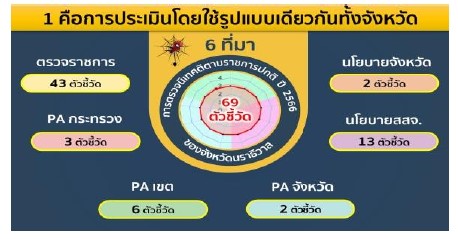การพัฒนารูปแบบการประเมินผลการปฏิบัติงานตามตัวชี้วัด สำนักงานสาธารณสุขจังหวัดนราธิวาส
พีรวรรณ ชีวัยยะ
คำสำคัญ:
การพัฒนา, รูปแบบการประเมินผลการปฏิบัติงาน, ตัวชี้วัดบทคัดย่อ
การวิจัยและพัฒนานี้ มีวัตถุประสงค์เพื่อพัฒนาและประเมินรูปแบบการประเมินผลการปฏิบัติงานตามตัวชี้วัด สำนักงานสาธารณสุขจังหวัดนราธิวาส ดำเนินการวิจัย 3 ระยะ ได้แก่ ระยะก่อนการพัฒนารูปแบบ ระยะพัฒนารูปแบบ และระยะประเมินผล ประชากรที่ใช้ในการศึกษาเป็นเจ้าหน้าที่ผู้ปฏิบัติงานในสังกัดสำนักงานสาธารณสุขจังหวัดนราธิวาสทุกระดับ จำนวน 4,521 คน ได้ขนาดกลุ่มตัวอย่าง 357 คน คัดเลือกโดยวิธีการสุ่มแบบบังเอิญ เครื่องมือที่ใช้ในการวิจัย คือ แบบสอบถามความคิดเห็น ระดับความเหมาะสมและความพึงพอใจของรูปแบบการประเมินผลการปฏิบัติงานตามตัวชี้วัด สำนักงานสาธารณสุขจังหวัดนราธิวาส ที่ผู้วิจัยพัฒนา และผ่านการตรวจสอบความสอดคล้องเนื้อหา จากผู้ทรงคุณวุฒิ 3 ท่าน มีค่า Index of item objective congruence (IOC) ระหว่าง 0.67 – 1.00 วิเคราะห์ข้อมูลด้วย ค่าเฉลี่ย ส่วนเบี่ยงเบนมาตรฐาน ผลการวิจัย พบว่า รูปแบบการประเมินผลการปฏิบัติงานตามตัวชี้วัด ประกอบด้วย 2 ส่วน คือ การกำหนดระดับเกณฑ์คะแนน และการจัดกลุ่มตัวชี้วัดจาก 6 แหล่ง จำนวน 69 ตัวชี้วัด ด้วยผังใยแมงมุม 4 ด้าน เป็นรูปแบบที่มีความเหมาะสม และมีความพึงพอใจ ระดับมาก (= 3.75, S.D. = 0.79) และ (= 3.75, S.D. = 0.80) เมื่อจำแนกรายด้าน ระดับความเหมาะสมที่ค่าเฉลี่ยสูงสุด คือ การกำหนดค่าคะแนน Template ( = 3.82, S.D. = 0.79) และระดับความพึงพอใจที่มีค่าเฉลี่ยสูงสุด คือ ความพึงใจต่อกระบวนการนิเทศกำกับติดตามลงเยี่ยมหน้างาน และการสรุปผลการประเมินหลังการเยี่ยมหน้างาน (Exit) (= 3.80, S.D. = 0.82) ซึ่งการมีรูปแบบการประเมินผลการปฏิบัติงานตามตัวชี้วัดที่มีความเหมาะสมมาก และผู้เกี่ยวข้องมีความพึงพอใจมาก จะช่วยส่งเสริมการปฏิบัติงานให้บรรลุเป้าหมาย และส่งผลให้ประชาชนเข้าถึงบริการสุขภาพมากขึ้น
เอกสารอ้างอิง
Adecco, (2020). Know Halo Effect, False Recruitment Trap. Retrieved March 10 2023, from https:// adecco.co.th/th/knowledge-center/detail/halo-effec.
Boonchom, S. (2010). Preliminary research. (8th printed). Bangkok: Suweeriyasarn. (inThai).
Joe, W. (2021). Everything You Need to Know about Scoring Models in Project Management. Retrieved March 21, 2023 from https://www.smartsheet.com/content/project-scoring.
Kimmy, B. (2022). What Is A Scoring Model In Project Management. Retrieved March 21, 2023 from https://www.kyinbridges.com/what-is-a-scoring-model-in-project-management/
Krejcie, R.V., & Morgan, D.W. (1970). Krejcie and Morgan Table; Determining Sample Size for Research Activities. Educational and Psychological Measurement. Retrieved May 21, 2022 from https://www.researchgate.net/publication/349118299_
Kusum, W. (2019). What is ‘POSDCORB’ Model; Health promotion and education. Retrieved December 23, 2022 from https://www.publichealthnotes.com/what-is-posdcorb-model/
Narathip, S. (2013). A Neglected Stage in Performance Management Process. Modern management Journal, 7(1), 13 - 22.
Navarat, W., Sunee, K., Rattiporn, B., & Diana, M. (2020). Model of Health Promotion Activities
in a School for the Elderly Using 3 Dimensions (Diet, Exercise, and Emotion) The Southern College Network. Journal of Nursing and Public Health, 7(2), 1 - 12.
Ong-art, N., Nipa, S., Duangchai, S., & Nophawan, S. (2015). Developing a Performance Evaluation System for Staff Members of Faculty of Education Srinakharinwirot Universiyt (SWU): Using the Individual Key Performance Indicator Approach. Srinakharinwirot Research and Development. Journal of humanities and social sciences, 7(14), 182 - 197.
Peter, C., & Anna, T. (2016). The Future of Performance Reviews: The Performance Management Revolution. Harvard Business Review. Retrieved May 21, 2023 from https://hbr.org/2016/ 10/the-performance-management-revolution
Public Health Office Narathiwat Province. (2022). Public health performance report for the year 2022. Author. (in Thai).
Sirikasem, S. (2020). Knowledge Management of Desirable Health Systems using the principle of Six Building Blocks Plus One. Retrieved December 23, 2022 from https://med.nu.ac.th/home/ DHS/eBooks/files/DHS-KnowledgeManagement.pdf.
Thanisara, K. (2019), Process and Technique of POSDCoRB. Journal of Association of Professional Development of Educational Administration of Thailand (JAPDEAT), 1(3), 15 - 22.
World Health Organization. (2010). Monitoring the Building Blocks of Health Systems: A Handbook of Indicators and Their Measurement Strategies. Geneva: WHO Document Production Servicves, Retrieved June 20, 2022 from https://apps.who.int/iris/bitstream/andle/10665/ 258734/9789241564052-eng.pdf
Yard, P. (2023). Rating Scales for Employee Performance Reviews. Retrieved August 21, 2023 from https://www.performyard.com › articles

ดาวน์โหลด
เผยแพร่แล้ว
รูปแบบการอ้างอิง
ฉบับ
ประเภทบทความ
สัญญาอนุญาต
ลิขสิทธิ์ (c) 2024 วารสารมหาวิทยาลัยนราธิวาสราชนครินทร์

อนุญาตภายใต้เงื่อนไข Creative Commons Attribution-NonCommercial-NoDerivatives 4.0 International License.



